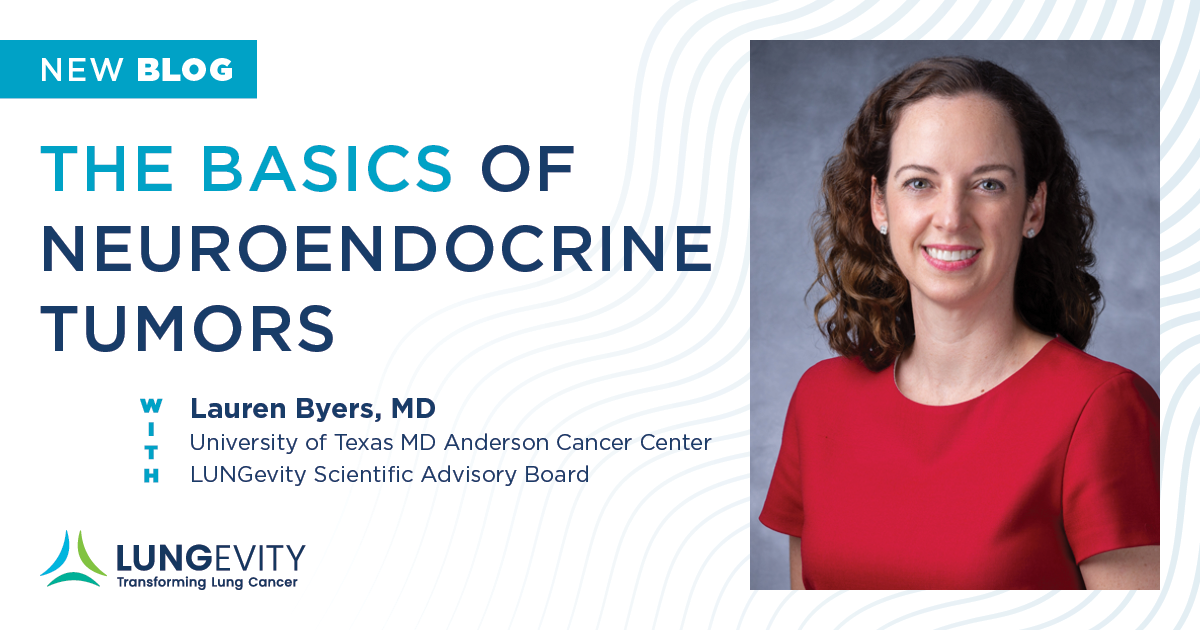Our lung tissue is made of different kinds of cells, including neuroendocrine cells. If these cells develop changes in their genome, they can begin to grow out of control and become tumors. Large cell lung cancer (which is the rarest form of non-small cell lung cancer) and small cell lung cancer (also referred to as SCLC) are both neuroendocrine tumors (NETs), derived from neuroendocrine cells in the lungs.
LUNGevity spoke with Lauren Byers, MD, professor in the Department of Thoracic/Head and Neck Medical Oncology at the University of Texas MD Anderson Cancer Center and a member of LUNGevity’s Scientific Advisory Board, to learn more about NETs and to understand the progress in treating these tumors.
LUNGevity Foundation: What are neuroendocrine tumors (NETs)?
Dr. Lauren Byers: These tumors form from neuroendocrine cells, which have the job of releasing hormones into the blood in response to a signal from the nervous system. Of course, lungs have many different types of cells, and neuroendocrine cells are one cell type that can accumulate genomic alterations and develop into cancer.
LF: Where are NETs found?
LB: When we are talking about NETs, it’s important to keep in mind that there are different types of NETs and these tumors can arise in many different areas of the body. This is because neuroendocrine cells are found in many places, including the digestive tract, lungs, skin, and thyroid.
LF: What are the types of NETs that are found in the lungs?
LB: There are four main types of NETs found in the lung that we can discuss today.
First, we have the two slower-growing tumor types: carcinoid tumors and atypical carcinomas. Carcinoid tumors are the slowest growing and the least aggressive form of NETs in the lung. Atypical carcinomas are also slow-growing tumors. Both of these types of NETs are often detected in early stages.
The two fast-growing types of NETs are small cell lung cancer (SCLC) and a rarer form of non-small cell lung cancer called large cell NETs or large cell neuroendocrine cancer. SCLC makes up about 15% of all lung cancer diagnoses while large cell NETs account for approximately 2% of diagnoses. Both forms of lung cancer are quite aggressive. They are more likely to spread through the blood stream and into the lymph nodes or to other parts of the body. They are often detected when the disease is at an advanced stage.
LF: How are NETs treated?
LB: For the slower-growing NETs in the lung — carcinoids and atypical carcinomas — surgery is typically the preferred treatment approach. However, if the tumor can’t be surgically removed for some reason, other local treatments, such as radiation therapy, can be a good option for patients. It’s important to note that because these tumors are more common in other parts of the body, particularly the digestive tract, patients are sometimes referred to oncologists specializing in cancers of the gastrointestinal tract.
Large cell NETs have not been studied as rigorously as SCLC. This is partly because it is a rarer form of lung cancer. The treatment options for large cell NETs are currently the same approaches that we use in SCLC.
LF: Tell us about your research into NETs.
LB: More research studies have been conducted in SCLC, so more is known about that. We do know that large cell NETs have a lot of similarities to SCLC tumors, but our recent research is revealing some differences too.
Working with my research team, I’ve been able to study SCLC cells to identify four subtypes of SCLC. Each of these subtypes has a biomarker that we hope can eventually be used to diagnose it and to personalize treatment. These studies are on-going. Our team is also looking for similar biomarkers for large cell NETs.
Going into this new research project, we expected similarities between the subtypes we found in SCLC and large cell NETs — and those are there. We also found a fifth subtype. We are working to identify biomarkers and potential treatments for this fifth subtype of large cell NETs.
Currently, oncologists are using SCLC protocols to guide treatment of patients with large cell NETs. This research gives us a path forward to biomarker testing in large cell NETs and hopefully will bring the first targeted treatment for patients with these tumors. We are hopeful that research in SCLC and large cell NETs will benefit patients with other types of NETs that started in other parts of the body as well.
LF: What role do patient advocacy groups, like LUNGevity, play in improving treatment options for rare lung cancer types?
LB: LUNGevity is helping to keep the pipeline of lung cancer researchers full. This brings lots of vibrancy, innovation, and collaboration to the field. The Career Development Award that I received from LUNGevity came at an important time in my own career as a researcher, and it helped me lay a strong foundation to launch my career and the careers of some incredible researchers, such as Dr. Carl Gay.
In the past, SCLC clinical trials didn’t include other NETs. Recently, though, my colleague and fellow LUNGevity Career Development Award recipient, Dr. Gay, started enrolling patients in a clinical trial for SCLC and he included an opportunity for patients with rare tumors to participate. It was amazing to see how quickly these patients enrolled because the patient networks and patient advocacy groups saw the opportunity, jumped on social media, and shared the enrollment information widely.
The lung cancer community is powerful when we come together and work toward common goals, such as building a world where no one dies of lung cancer.

